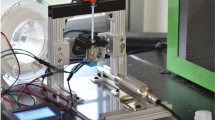Abstract
Purpose
Lab-on-a-chip devices, where small channels and reaction chambers have to be covered with a sealing lid, laser beam welding has already been proven to show considerable potential for standard material combinations. To avoid absorbing additives, the wavelength of the laser has to fit the absorption bands of the polymers. For it to achieve a localized weld seam, the laser beam has to be strongly focused.
Methods
To achieve the desired temperature distribution, we establish and discuss the heat rate generated by a focused beam as a function of the absorption coefficient and the Rayleigh length. Thermal simulation of the weld process reveals the dependence of the temperature on Rayleigh length and absorption coefficient. Experiments were carried out with a tunable laser source emitting between 700 and 1000 nm on polycarbonate samples doped with Lumogen 788 dye. Microtome cuts of the welded samples reveal the dimensions of the heat-affected zone and, therefore, of the seam.
Results
Experimental and simulation results show that for typical welding conditions a localized seam inside a sample can be achieved with an appropriate focusing of the laser beam and tuning of the wavelength. The dimensions of the heat-affected zone decrease as absorption coefficient decreases and welding velocity increases. The discussion of the functional dependence of the heat rate on absorption coefficient and Rayleigh length shows that Rayleigh length and sample thickness have to be smaller than the optical penetration depth.










Similar content being viewed by others
References
N.N., Microfluidic Devices Market Overview, 2018, https://www.psmarketresearch.com/market-analysis/microfluidic-devices-market. Accessed 05 Mar 2019
D. Bonefeld, Eigenspannungen, Spaltüberbrückung und Strahloszillation beim Laserdurchstrahlschweißen, Schriftenreihe / Institut für Polymere Materialien und Prozesse. Universität Paderborn 2012,1, Shaker, Aachen, 2012
Boehm, A, J, laser transmission welding of plastics in medical device manufacturing − how to choose the right laser additive. Proceedings of the 2nd international conference on joining plastics, London 2006 (2006)
T. Ebert, Den Durchblick behalten-Transparente Kunststoffe mit Laser fügen. Kunststoffe (1999) 58–60
P. Laakso, Ruotsalainen, S, G. Otto, Olowinsky, A, V. Kujanpää, Butt welding of transparent polyamide (PA11) with 1.94 μm fiber laser. Proceedings of the 32nd International Congress on Applications of Lasers & Electro-Optics (ICALEO (2013) 175–180
Mingareev, I., Weirauch, F., Olowinsky, A., Shah, L., Kadwani, P., Richardson, M.: Welding of polymers using a 2μm thulium fiber laser. Opt Laser Technol. 44(7), 2095–2099 (2012)
Mamuschkin, V., Olowinsky, A., van der Straeten, K., Engelmann, C.: Laser transmission welding of absorber-free thermoplastics using dynamic beam superposition. Laser-based Micro- and Nanoprocessing IXProc SPIE. (2015)
Jackson, J.D.: Classical Electrodynamics. John Wiley & Sons, New York (1975)
Siegman, A.E.: LASERS, University Science Books. Sausalito, California (1986)
Allen, L., Beijersbergen, M.W., Spreeuw, R.J.C., Woerdman, J.P.: Orbital angular momentum of light and the transformation of Laguerre-Gaussian laser modes. Phys Rev A. 45(11), 8185–8189 (1992)
Erikson, W.L., Singh, S.: Polarization properties of Maxwell-Gaussian laser beams. Phys Rev E. 49(6), 5778–7786 (1994)
Guizar-Sicairos, M., Gutiérrez-Vega, J.C.: Propagation of Helmholtz-gauss beams in absorbing and gain media. J Opt Soc Am A. 23(8), 1994 (2006)
Rauschenberger, J., Vogler, D., Raab, C., Gubler, U.: In: Klotzbach, U., Washio, K., Arnold, C.B. (eds.) Diffractive Beam Shaping for Enhanced Laser Polymer Welding, 935110. SPIE (2015)
Aden, M.: Influence of the laser-beam distribution on the seam dimensions for laser-transmission welding: a simulative approach. Lasers Manuf Mater Process. 3(2), 100–110 (2016)
Eichler, J., Dünkel, L., Eppich, B.: Die Strahlqualität von Lasern – Wie bestimmt man Beugungsmaßzahl und Strahldurchmesser in der Praxis? LTJ. 1(2), 63–66 (2004)
Siegman, A.E.: High-power laser beams: defining, measuring and optimizing transverse beam quality. Proc SPIE. 758–765 (1993)
Acknowledgements
The investigations presented here were carried out as part of the research project “AFRELAS” funded by AiF, the German Federation of Industrial Research Associations to whom we would like to express our special gratitude. Particular thanks go to the company Treffert GmbH & Co. KG, especially to Dr. Sibylle Glaser, for providing the specimen material.
Author information
Authors and Affiliations
Corresponding author
Additional information
Publisher’s Note
Springer Nature remains neutral with regard to jurisdictional claims in published maps and institutional affiliations.
Rights and permissions
About this article
Cite this article
Mamuschkin, V., Aden, M. & Olowinsky, A. Investigations on the Interplay Between Focusing and Absorption in Absorber-Free Laser Transmission Welding of Plastics. Lasers Manuf. Mater. Process. 6, 113–125 (2019). https://doi.org/10.1007/s40516-019-00083-1
Accepted:
Published:
Issue Date:
DOI: https://doi.org/10.1007/s40516-019-00083-1




